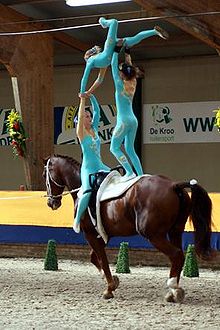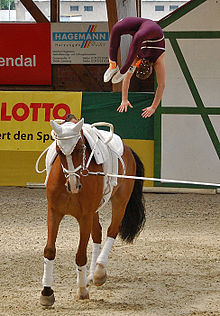| Home Competition Index | First Posted: Feb 18, 2011 Jan 21, 2020 | |
Horse (Equine) Vaulting
  Freestyle team vaulting Individual Vaulting Equestrian vaulting is most often described as gymnastics and dance on horseback, and like these disciplines, it can be practised as a non-competitive art or as a competitive sport. It is open to males and females. It is one of ten equestrian disciplines recognized by the International Federation for Equestrian Sports, along with: dressage, combined driving, endurance riding, eventing, horseball, paraequestrian, reining, and show jumping, and tent pegging. Therapeutic or Interactive Vaulting is also used as an activity for children and adults who may have balance, attention, gross motor skill, or social deficits. Vaulting has many enthusiasts worldwide, but particularly in Germany, where it is often practised as part of basic equestrian training. The German vaulting squads are highly ranked and very competitive on the world stage. Vaulting is also especially well established in Switzerland and France (where it is known as Voltige), Austria, Sweden, the UK, the United States, and the Netherlands. Enthusiasm for the art is also growing in Brazil, Australia, and in South Africa. Competitive VaultingIn competitive vaulting, vaulters compete as individuals, pairs or pas-de-deux, and teams. Beginning vaulters will compete at the walk (and in the US at the trot) but copper-, bronze-, silver-, and gold-medal level vaulters perform on the horse at a canter. The vaulting horse, which has been carefully trained, moves in a 15-metre circle and is controlled by a lunger Vaulting competitions consist of compulsory exercises and choreographed freestyle exercises done to music. There are six compulsories exercises-basic seat, flag, mill, scissors, stand, and flank, in addition to the mount and dismount. Each exercise is scored on a scale from 0-10. Horses also receive a score and are judged on the quality of their gait. Vaulters also compete in freestyle (previously known as Kur). The components of a freestyle vaulting routine MAY include mounts and dismounts, handstands, kneeling and standing and aerial moves such flips. Teams will also carry, lift, and even toss another vaulter in the air. Judging is based on technique, performance, form, difficulty, balance, security, and consideration of the horse-the horse as well as the vaulter earns a score. Vaulting horses are not saddled, but they do wear a surcingle (or a roller) and a thick back pad. The surcingle has special handles which aid the vaulter in performing certain moves as well as leather loops called cossack stirrups. The horse wears a bridle and side reins. The lunge line is usually attached to the inside bit ring. Vaulting horses typically move on the left rein (counterclockwise), but in certain kinds of competitions the horse will canter in the other direction. Two-phase classes of competition also work the horse to the right. While many European teams do not work to the right, many American vaulting clubs work to the right believing this benefits the horse and the vaulter. The premier Vaulting competitions are the biannual World and Continental Championships and the World Equestrian Games (WEG) held every four years. In the United States, the American Vaulting Association organizes and sponsors national, regional and local events every year, such as Falconwood Springfest in Covington, Georgia. Vaulting events were included in the 1920 Olympics. HistorySome trace the origins of vaulting to Roman games, including acrobatic displays on cantering horses. Others see roots in the bull dancers of ancient Crete. In either case, people have been performing acrobatic and dance-like movements on the backs of moving horses for more than 2,000 years. The first known depiction of vaulting was from stone painting, dated at around 1500 BC, of Scandinavian riders standing on horses. Renaissance and Middle Ages history include numerous references to vaulting or similar activities, and it seems apparent that present-day gymnastics performed on the "vaulting horse" was developed from vaulting - allowing concentration on the gymnastics without the horse. The present name of the art comes from the French "La Voltige," which it acquired during the Renaissance, when it was a form of riding drill and agility exercise for knights and noblemen, and also used as a symbol of status. Vaulting was later used to help cavalry troops increase their abilities on the horse, and the troops would begin by working on a wooden horse before advancing to a live, moving mount. Modern vaulting was developed in post-war Germany as part of set of exercises for improving general riding. Cavalry officers introduced the art at the 1920 Olympic Games in Antwerp as "Artistic Riding," although the art was not continued in the Games. Vaulting is still much more popular in Europe, where it is still included in dressage training, than it is in other parts of the world, though vaulting is a growing art in Australia, Brazil, Canada, and the United States. In 1983, vaulting became one of the disciplines recognized by the Fédérationéquestre internationale (FEI), and the first FEI World Vaulting Championships were held in Switzerland in 1986. It was later demonstrated as an art at the 1996 Atlanta Games and at the 1984 Olympic Games in Los Angeles, USA. More recently, the popular equestrian show Cavalia and other similar shows have introduced vaulting to many new audiences worldwide. MovementsVaulters perform various movements on the back of the horse. Novice and beginning vaulters may perform at the walk or the trot while higher level vaulters perform at the canter. There are six compulsory exercises in the individual competition that must be performed without dismounting:
The compulsories are performed in succession in the above order, without pause or dismounts. In addition, the mount onto the horse is also scored. At the walk, the Ground Jump is omitted. In the team competition, each vaulter performs the required movements, one following the other. Each team member will do the first three moves and then dismount, and after everyone has done the first three, the team will get back on one by one and finish out the last three moves. United States and the AVAAmerican vaulting can be traced to 1956, when Elizabeth Searle first saw the art during a visit to Europe. Seeing a potential application for her pony club in California's Santa Cruz County, she obtained a 16mm film of the basic exercises, and took it back to the US. Later, in 1966, the American Vaulting Association was founded by Searle and J. Ashton Moore, and in 1969, held the first official AVA competition at the Santa Cruz County fairgrounds in Watsonville, California. In 1974, US vaulters participating in the first international exchange in Stuttgart, Germany. AVA members demonstrated vaulting at the 1984 Summer Olympics in Los Angeles, and again at the Atlanta Olympic games in 1996. Today the AVA has more than 1,000 members in 100 AVA clubs and affiliates from Hawaii to Massachusetts, and Washington to Florida. Originally focused solely on competitive vaulting, the AVA today has programs for all types of vaulters, from recreational and pony club vaulters to therapeutic vaulters, from beginner to world championship levels. Non-Competitive VaultingIn addition to competition, vaulting is also a form of artistry and entertainment. Cavalia, the blockbuster equestrian theatrical show from Canada, includes a vaulting section. Beyond Cavalia, vaulting is also used on a therapeutic level in some instances. People with disabilities can often benefit from interacting with the horse and team members, and by doing simple movements with the help of "spotters." Also, vaulting is often seen on a recreational level, through vaulting "demonstrations," and occasionally in local parades. For photographs and other information concerning vaulting in the United States, see the official American Vaulting Association's.For More Information: International Vaulting ClubInternational Championships A Brief History of Vaulting/UK |